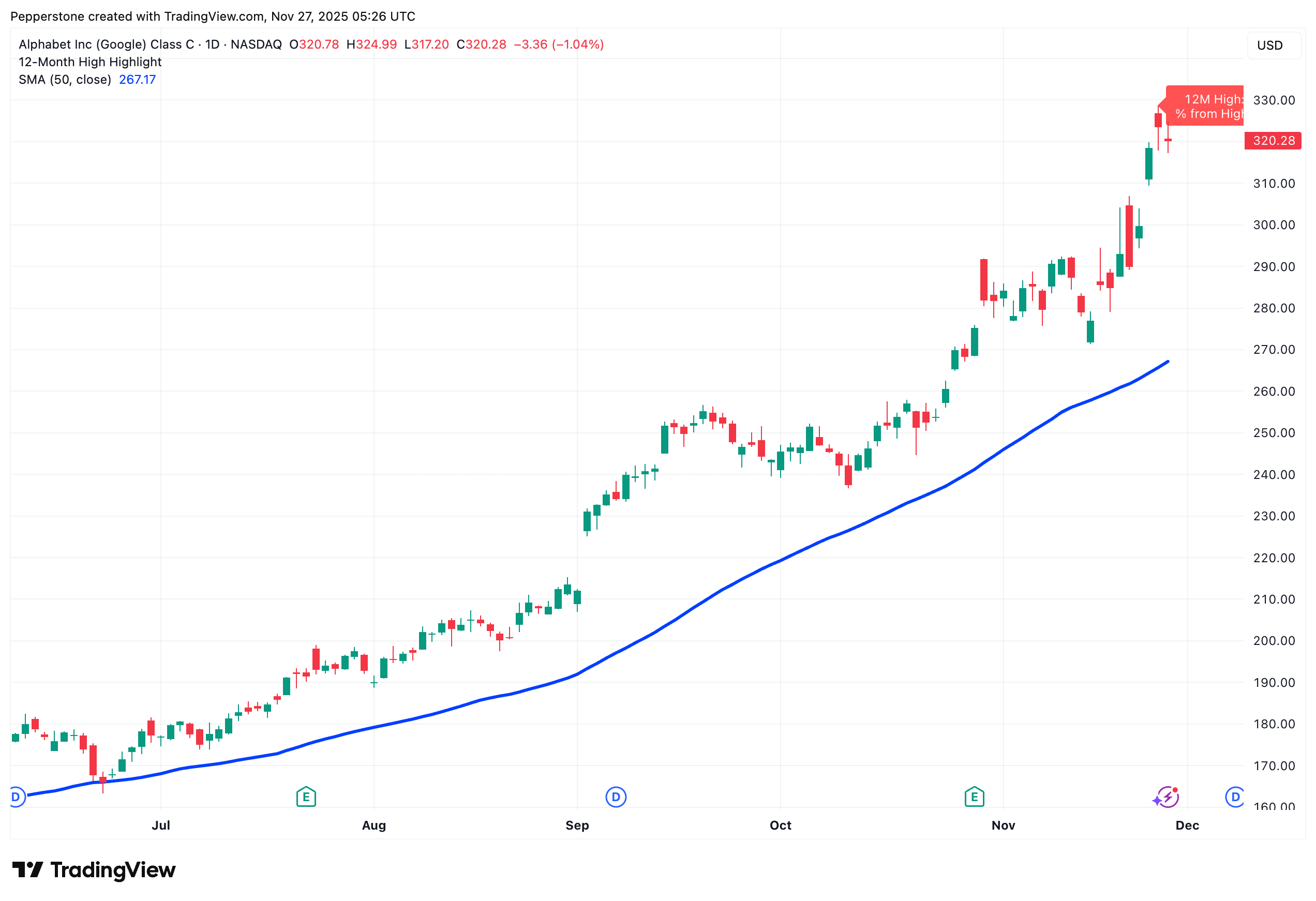- English
- 中文版
AI Midgame: How Google & Alibaba’s Ecosystems Are Shaping the U.S.-China Race
.jpg)
After the tech sell-off sparked by concerns over an “AI bubble,” market risk sentiment has noticeably improved. A key driver is rising liquidity expectations—markets now price in nearly a 90% chance of a Fed rate cut in December, coupled with the imminent end of balance sheet reductions, which has reactivated buying interest.
However, the AI sector’s performance remains uneven. In the U.S., companies like Nvidia, AMD, and Oracle continue to face pressure, while Google’s Gemini 3 has pushed its stock up roughly 10% over two weeks.

In China, Alibaba delivered a strong Q2 report, and Ant Group’s AI assistant “LingGuang” reached over 2 million downloads in just six days, attracting trader attention.
Policy support is also ramping up. Trump signed the Genesis Mission executive order, placing AI at the center of U.S. national strategy, while China’s 15th Five-Year Plan positions AI as a core driver of economic transformation. AI is no longer just a commercial competition—it now directly impacts industrial leadership and capital flows.
Google and Alibaba: Full-Stack Ecosystems Driving Value
Following the launch of Gemini 3, Google’s stock surged, sparking discussion among traders about whether it could disrupt the existing “Nvidia chain.” Meanwhile, Alibaba Cloud revenue grew 34% year-on-year, and the Qwen app exceeded 10 million downloads within a week.
These developments show that breakthrough AI products aren’t just about single-point innovation—they come from tech giants that build full ecosystems and execute quickly.
Though their focuses differ— Google leans on information, Alibaba on applications—their business structures are similar: in-house compute, core models, applications, and user data.
- Google:Proprietary TPUs support compute, while the Gemini model powers search, YouTube, and the Android ecosystem. Upgrades benefit not only individual products but the ecosystem as a whole.
- Alibaba:Combining compute infrastructure, the Qwen model, and upper-layer apps like Taobao and Alipay, Alibaba rapidly expands its user base, significantly increasing C-end penetration.
For traders, full-stack ecosystem companies provide two key takeaways:
- Resilience to risk:Even amid sector volatility, integrated ecosystems and revenue cycles help buffer the impact.
- Leading user metrics:Downloads, engagement, and monetization often signal capital flows ahead of financial reports, offering valuable short-term insights.
Diverging U.S.-China AI Strategies
The U.S. and China are taking clearly different approaches to AI, which directly affects capital flows and valuations.
Trump’s “Genesis Mission” order accelerates U.S. efforts in AGI and infrastructure while extending applications into energy, materials, and life sciences, giving America a long-term policy, capital, and strategic edge—but with longer commercialization timelines.
China emphasizes applied technology and faster monetization. The draft 15th Five-Year Plan stresses original innovation and technological self-reliance, positioning AI as a key driver of economic transformation over the next five years. Chinese companies thus focus on rapidly converting technology into revenue and user growth rather than pursuing purely theoretical breakthroughs.
In the short term, markets favor companies that can quickly turn technology into profits and user expansion. Over the longer horizon, both technological potential and policy support must be considered.
Execution and Ecosystem Integration Determine Market Direction
By late 2025, AI’s midgame is clear.While concept hype persists, market patience is fading. The recent successes of Google and Alibaba reflect not just technical innovation but the market’s recognition of ecosystem building and commercial execution.
Key trends to watch include:
- Full-stack tech giants are more resilient:Companies with in-house compute, core models, and application ecosystems withstand sector swings better and offer clearer long-term value. Besides Google and Alibaba, Tencent and Baidu are notable examples.
- C-end application performance matters:Metrics like downloads, active users, and monetization directly reflect capital sentiment and sector heat, making them especially useful for short-term analysis.
- Policy and global adoption indicate potential upside:Overseas adoption of domestic AI models, government support, and cross-border expansion can signal early capital flows and valuation growth.
Overall, the short-term market hinges on execution and ecosystem integration. Companies that can most quickly translate technology into usable products and revenue streams are likely to attract capital first and realize growth potential.
The material provided here has not been prepared in accordance with legal requirements designed to promote the independence of investment research and as such is considered to be a marketing communication. Whilst it is not subject to any prohibition on dealing ahead of the dissemination of investment research we will not seek to take any advantage before providing it to our clients.
Pepperstone doesn’t represent that the material provided here is accurate, current or complete, and therefore shouldn’t be relied upon as such. The information, whether from a third party or not, isn’t to be considered as a recommendation; or an offer to buy or sell; or the solicitation of an offer to buy or sell any security, financial product or instrument; or to participate in any particular trading strategy. It does not take into account readers’ financial situation or investment objectives. We advise any readers of this content to seek their own advice. Without the approval of Pepperstone, reproduction or redistribution of this information isn’t permitted.